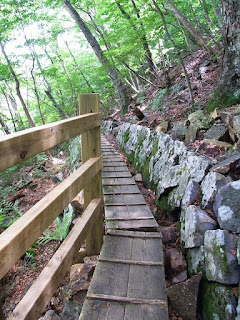Kinugawa Onsen town itself was thoroughy unremarkable, though it would have been beautiful once. Oversized ferro-concrete apartment blocks that have been built to accommodate large groups of sightseers who want an onsen (hot spring) experience close to public transport dominated the landscape, laying waste to the nature that originally made the destination appealing. The Japanese bubble has long passed and several o buildings seemed to have been abandoned, leaving the town with a rather tired and forlorn atmosphere. The tourist centre there did have good information though. We picked up a pamphlet for Ryuokyo, a place neither of us had heard of, but the pictures looked good :) And so we headed on.
Ryuokyo looked like the pick of the pamphlets: a ravine, waterfalls, sheer cliffs, nature trails, forest, an endangered frog preservation area. It is a couple of stops north of Kinugawa Onsen on the Yagan Minami Aizu Railway line (change at Shin Fujiwara), though we continued by bike. For a Sunday in summer, there were few sightseers, though I imagine in autumn the spectacular colours would bring armies of leaf watchers. The sightseers who were there almost all walked down the steps to the see the first waterfall, and then promptly returned to the point of origin, without traversing the nature trails. All the more peaceful for us!
After some consideration we opted to follow a loop path that took about 45 minutes rather than walk the full length of the nature trail (est. 3 hours). The longer walk had appeal, but the trains back only run every hour, and waiting for 50 min for a train had no appeal...
The terrain was similar to Shosenkyo, which we visited in April, though unlike Shosenkyo where the walking trail is by the edge of the gorge, the nature trails were up to 10 metres back from the edge, making the forest rather than the ravine the attraction. But it was definitely worth seeing, and made for a very pleasant day trip from Tokyo.
Ryuokyo station on the Yagan Aizu Kinugawa Line
The fare table at Ryuokyu station - only in Japanese but it shows the prices and where the Kinugawa-Aizu line joins up with other lines.
A map of the nature trails
Upstream

The waterfall that most sightseers seem to come to see.

On the nature path
The walking path by the gorge has a lot of steps and walking boards to minimize the impact of human traffic.







No comments:
Post a Comment